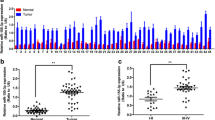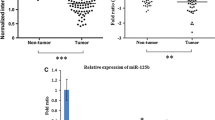Abstract
Hepatocellular carcinoma (HCC) originates from liver cells and is one of the most common malignant cancers in the world. microRNAs (miRNA), are single strand non-coding RNA molecules with the length of 18–25 nucleotides. miRNAs play an important role in the development of HCC, i.e., miRNAs have a significant impact on multistep hepatocellular carcinogenesis including cellular migration and invasion. URG4/URGCP (up-regulated gene-4/upregulator of cell proliferation) is up-regulated in the presence of HBxAg and has been identified and characterized by Satiroglu-Tufan et al. The full-length URG4/URGCP is 3.607 kb. Overexpression of URG4/URGCP in the presence of HBV X protein may function as a putative oncogene that significantly contributes to multi-step hepatocarcinogenesis. In this study, we aimed to investigate potential miRNA expression changes in HepG2 cell line model system in the presence of URG4/URGCP and in the absence of URG4/URGCP, which was suppressed by RNA interference. To functionally characterize URG4/URGCP, independent cultures of HepG2 cells were stably transfected with pcDNA3 or pcDNA3-URG4/URGCP. Relative quantification of whole genome miRNAs was analyzed by RT-PCR using human whole genome miRNA qPCR profiling kits. Among the 1,034 human miRNAs investigated by the arrays, 77 miRNAs were up-regulated and nine miRNAs were down-regulated in the presence of URG4/URGCP. In conclusion, we have analyzed miRNA profiles in HepG2 cells in presence or absence of URG4/URGCP gene using RNA interference. Some of these miRNAs may play roles in URG4/URGCP gene related disease development through the regulation of different signaling pathways.



Similar content being viewed by others
References
Bartel DP (2004) MicroRNAs: genomics, biogenesis, mechanism, and function. Cell 116:281–297
Bushati N, Cohen SM (2007) microRNA functions. Annu Rev Cell Dev Biol 23:175–205
Lu M, Zhang Q, Deng M, Miao J, Guo Y, Gao W, Cui Q (2008) An analysis of human microRNA and disease associations. Plus One 3(10):e3420
Chen CZ (2005) MicroRNAs as oncogenes and tumor suppressors. N Engl J Med 353:1768–1771
Lim LP, Lau NC, Garrett-Engele P et al (2005) Microarray analysis shows that some microRNAs downregulate large numbers of targetmRNAs. Nat Genet 433:769–773
Parkin DM, Bray F, Ferlay J, Pisani P (2005) Global cancer statistics. CA Cancer J Clin 55:74–108
Calin GA, Sevignani C, Dumitru CD, Hyslop T, Noch E, Yendamuri S et al (2004) Human microRNA genes are frequently located at fragile sites and genomic regions involved in cancers. Proc Natl Acad Sci USA 101:2999–3004
Tufan NL, Lian Z, Liu J et al (2002) Hepatitis Bx antigen stimulates expression of a novel cellular gene, URG4 that promotes hepatocellular growth and survival. Neoplasia 4:355–368
Song J, Xie H, Liany Z et al (2006) Enhanced cell survival of gastric cancer cells by a novel gene URG4. Neoplasia 8:995–1002
Huang J, Zhu B, Lu L, Lian Z, Wang Y, Yang X, Satiroglu-Tufan NL, Liu J, Luo Z (2009) The expression of novel gene URG4 in osteosarcoma: correlation with patients’ prognosis. Pathology 41:49–54
Lian Z, Pan J, Liu J, Zhang S et al (1999) The translation initiation factor, hu-Sui1 may be a target of hepatitis Bx antigen in hepatocarcinogenesis. Oncogene 18:1677–1687
Jiang J, Gusev Y, Aderca I et al (2008) Association of MicroRNA expression in hepatocellular carcinomas with hepatitis infection, cirrhosis, and patient survival. Clin Cancer Res 14:419–427
Pineau P, Volinia S, McJunkin K et al (2010) miR-221 overexpression contributes to liver tumorigenesis. Proc Natl Acad Sci USA 107:264–269
Jopling CL, Yi M, Lancaster AM, Lemon SM, Sarnow P (2005) Modulation of hepatitis C virus RNA abundance by a liver-specific microRNA. Science 309:1577–1581
Calin GA, Croce CM (2006) MicroRNA signatures in human cancers. Nat Rev Cancer 6(11):857–866
Gaur A, Jewell DA, Liang Y et al (2007) Characterization of microRNA expression levels and their biological correlates in human cancer cell lines. Cancer Res 67(6):2456–2468
Lu J, Getz G, Miska EA et al (2005) MicroRNA expression profiles classify human cancers. Nature 435(7043):834–838
Murakami Y, Yasuda T, Saigo K, Urashima T, Toyoda H, Okanoue T, Shimotohno K (2006) Comprehensive analysis of microRNA expression patterns in hepatocellular carcinoma and non-tumorous tissues. Oncogene 25:2537–2545
Pineau P, Volinia S, McJunkin K et al (2010) miR-221 overexpression contributes to liver tumorigenesis. Proc Natl Acad Sci USA 107:264–269
Li W, Xie L, He X et al (2008) Diagnostic and prognostic implications of microRNAs in human hepatocellular carcinoma. Int J Cancer 123:1616–1622
Qu KZ, Zhang K, Li H, Afdhal NH, Albitar M (2011) Circulating microRNAs as biomarkers for hepatocellular carcinoma. J Clin Gastroenterol 45(4):355–360
Tan S, Li R, Ding K, Lobie PE, Zhu T (2011) miR-198 inhibits migration and invasion of hepatocellular carcinoma cells by targeting the HGF/c-MET pathway. FEBS Lett 585(14):2229–2234
Furuta M, Kozaki KI, Tanaka S, Arii S, Imoto I, Inazawa J (2010) miR-124 and miR-203 are epigenetically silenced tumor-suppressive microRNAs in hepatocellular carcinoma. Carcinogenesis 31(5):766–776
Satiroglu-Tufan NL, Dodurga Y, Gok D, Cetinkaya A, Feitelson MA (2010) RNA interference-mediated URG4 gene silencing diminishes cyclin D1 mRNA expression in HepG2 cells. Genet Mol Res 9(3):1557–1567
Tutuncu B, Kuçukatay V, Arslan S, Sahin B, Semiz A, Sen A (2012) Alteration of drug metabolizing enzymes in sulphite oxidase deficiency. J Clin Biochem Nutr 51(1):50–54
Author information
Authors and Affiliations
Corresponding author
Rights and permissions
About this article
Cite this article
Dodurga, Y., Yonguc, G.N., Avci, C.B. et al. Investigation of microRNA expression changes in HepG2 cell line in presence of URG4/URGCP and in absence of URG4/URGCP suppressed by RNA interference. Mol Biol Rep 39, 11119–11124 (2012). https://doi.org/10.1007/s11033-012-2019-8
Received:
Accepted:
Published:
Issue Date:
DOI: https://doi.org/10.1007/s11033-012-2019-8




